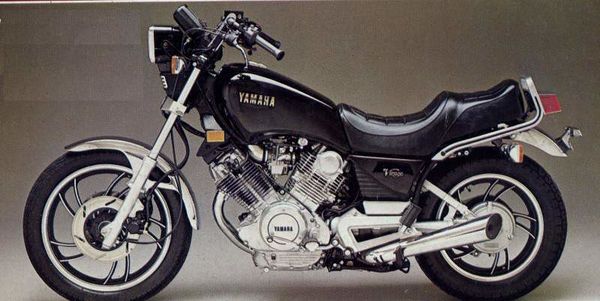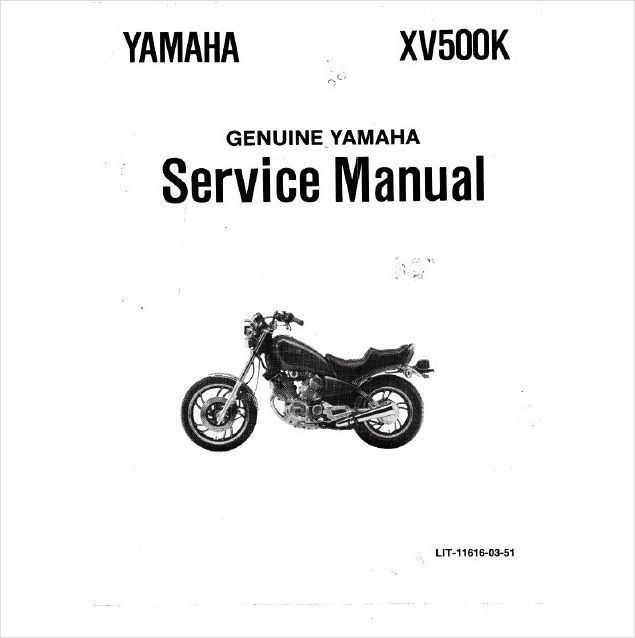
The engine is a stressed member of the frame, and there are no downtubes or engine cradle tubes. The four forward cyk inder studs extend above the cylinder head and attach to a plate suspended from the frame's backbone. That backbone is formed of stamped steel plates, welded together in box section and curving from steering stem to swing arm pivot. The rear of the engine bolts to the backbone in two places, one above and one below the swing arm pivot.
The backbone is sealed and serves as the air intake system. A rubber plenum, located under the seat and left sidecover,
feeds air into the backbone, which forms a still air box. A pleated paper air cleaner fits into the backbone just above the carburetors.
A single rear shock bolts to the backbone, under the front of the seat, and runs down and back to a triangulated steel swing arm. The frame rear subsection, which supports the seat and tail section, bolts to the backbone tube on the top and the footpeg carriers on the bottom. The swing arm pivots in tapered roller bearings.
The leading-axle non-adjustable forks have 36mm stanchion tubes held by a steel lower triple clamp and an aluminum upper clamp. These clamps are different in more than material. The lower triple clamp has less offset than the top triple clamp, so the Steering Head Angle is different from the fork rake. The difference is 1.5°, the steering head set at 29°, the forks set at 27.5°, producing a long 4.9 in. of trail. Two rubber-mounted risers bolt to the top triple clamp and hold the tubular steel pullback handlebars. The front wheel is 1.85 in. wide and holds a 3.00-19 Bridgestone L303 tire, the rear rim is 2.5 in. wide and holds a 130/90-16 Bridgestone G509 tire. Both wheels are cast aluminum in the now common swirl pattern used on most Yamaha Virago and Maxim models. An 11.75 in. disc is used for the front brake and a 7.1 in. drum is used in back.
Because the lowest part of the teardrop-shaped gas tank is lower than the carburetor float bowls, an electric fuel pump is used to feed the carbs. The pump supplies more fuel than the carburetors need, the surplus recirculating to the gas tank. According to Yamaha engineers, this recirculation system lowers gasoline temperatures an average of 50°. Lowering fuel temperatures can reduce evaporative emissions, which will be controlled on California motorcycles in 1984.
Instruments include a 120-mph speedometer and a 10,000 rpm electric tach (redline is 8500 rpm), with a simple row of warning lights positioned below the instrument faces. Those lights indicate turn signal and high-beam use, low oil level and neutral selection. There isn't a fuel gauge; the gas tank petcock has a reserve position.
Comes now a persuasive case for simplicity. Because the two are very different motorcycles from the same factory, the Virago 500 and Vision 550 can be considered as two ends of same scale. Yamaha claims a modest 33 bhp for the Virago, an impressive 68 bhp for the Vision. However, the Virago's claimed torque is 30.4 lb.-ft. at 7000 rpm against the Vision's 34 lb. ft. at 8000 rpm, and with tanks half full the Virago weighs 402 lb. and the Vision weighs 482 lb.
Power requires weight, tuning means the power grows out of rpm, and torque is mostly a function of displacement.
And at the drag strip the Virago turned 13.70 sec. for the quarter mile with a trap speed of 93.55 mph and the Vision (Cycle World, April 1983) did 13.05 sec. at 99.33 mph. More to the point in daily living, in top gear acceleration the Virago is actually quicker; 40-60 mph in 5.4 sec. vs 5.8 for the Vision.
Sure, the sporting Vision is quicker and faster and the more complex package can justify itself.. to the rider who wants it.
(It's also interesting to note how close are the middleweight and big Twins, from Yamaha, Honda, Harley, BMW, Triumph, et al. Be they 1000, 750, or 500cc, they all turn the quarter mile in the high 12s to high 13s while the big Fours are much quicker than their smaller brothers.)
At any rate, the Virago's strong mid-range and easy-on torque supply make it great fun to ride on the street. It's perfectly happy tooling down the road at less than 3000 rpm, and will leave traffic behind when short-shifted at 4000 rpm. It's equally happy when run to the red-line in every gear, the power delivery strong and steady with an extra kick of bhp above 6000 rpm.

The 500 is more willing to rev quickly than the larger Viragos and stays smoother in the process. Belly dance bvh files online. The 500 responds whenever the throttle is opened, no matter where the engine is in the rpm range. There isn't any surge at steady throttle when threading through traffic jams, and there's no hesitation off idle when the throttle is opened quickly. And all the time there's that intriguing V-Twin exhaust note, muffled on the 500 but there just the same, the off-cadence beat that says, well, motorcycle.
Some notes on smoothness, or maybe on size: We have all read and heard at great length about counterbalancers, rubber mounts, offset crankpins, frames tuned to absorb engine shake and other ways to cure or dissipate the vibrations inherent in any Twin.
Know what works? Size, or more accurately lack of size.
The technical advances mentioned above are advances. They do quell the tremors. But when an engine has smaller pistons it also has smaller tremors and the uncomplicated little Virago is smoother than the 750 or 920 Viragos or the Honda Shadow 750 or Harley 1000. There are vibrations, sure, but what the rider gets is little more than a reminder of an engine at work. No problem here, the mirrors even remain clear at cruising speed.
The Virago 500 is also a narrow engine, just 13.5 in. across, and the combination of narrowness, light weight and the broad powerband encourages sporty riding. Apeiron x keygen for mac. The Virago is an in-between size, feeling more a full-size motorcycle than a 450 or 400 and seeming incredibly light compared to most 550s, especially 550s with Inline Four engines.
The light weight and short wheelbase make the Virago nimble, good for cornering, and make it more easily disturbed by sidewinds and wind blasts from semitrailers on the highway, not so good for straight-line touring. But the Virago is stable at top speed and in fast, sweeping corners. The suspension is not adjustable (except for rear shock preload) and comes set up a bit on the stiff side. The trade-off is a choppy ride over repetitive bumps in the roadway.
Speaking of trade-offs, we've arrived at the Virago 500's downside. It began back on the drawing board, when the Virago 500 was scaled down.
The cruiser look began as a chopper look and choppers were originally built from Really Big Twins. Low seats, kick-out front ends, stretched wheelbases and the riders could easily lean back, put their feet up and stretch out. Those first Specials, Customs, etc. had the look but not the dimensions. Since then the Big Four has learned to deliver the looks after amending the style to allow for more compact machines.
This works up to a point; the Yamaha XSl 100 and Honda CB1000C, for example, can be cruised and ridden while the Honda 650 Night-hawk has cruiser elements while still being fine in daily use.
The Virago 500, though, doesn't have the wheelbase or any of the other distances to be both a cruiser and a good place on which to go riding. Riders of average height found the 500 cramped. The bars come back too far and the ends rotate inward toward the tank, making the bars into tillers. The bend of the bars cock the rider's wrists at an unusual angle and, because the control pods are shaped to follow the handlebar contours, makes it harder to reach the controls with the thumb.

The horn button, for example, is tucked down and inward on the left control pod, and the one time one rider needed the horn, all he got with his thumb was a blank space on the control pod. The footpegs had some riders searching for someplace to put their feet during long rides, and the one-position-only seat didn't help riders avoid feeling cramped. Those are the prices of the Virago's style.
The horn—or, more correctly, the
horns—are loud enough when the button is finally located. The headlight was everything a headlight should be bright penetratingly and perfectly aimed. The turn signals are self-cancelling, and can be manually over-ridden by pushing down on the side-to-side signal switch. Over-riding the signals often caused the switch to hang-up the next time the rider wanted to signal a turn, and it took prodding and poking at the switch before the signals lit again.
The Virago's brakes are good enough, being very controllable throughout our stopping tests. From 60 mph, the bike needed 119 ft. to stop; from 30 mph, 30 ft.
On the Cycle World mileage test loop, the Virago 500 returned 51 mpg in the standard combination of open highway, country road and city traffic. Ridden hard on backroads, mileage dropped to 47 mpg.
The fuel tank holds 2.9 gal., which gives the Virago a total range of between 136 and 148 mi., depending upon how it's ridden. Reserve is usually good for 16-20 mi. at highway speeds.
So what have we in this Virago 500? We have a V-Twin simpler and lighter that the Yamaha Vision, and, at a suggested list price of $2299, less expensive as well. The flip side of that is that the Virago isn't as quick or fast at the dragstrip.
The Virago is fun to ride, feels light and agile, sounds neat, gets good gas mileage. It also compromises rider comfort with styling, styling far enough into the cruiser mode to deter riders who don't care for that look, yet perhaps too conservative to appeal to hard-core cruiser fans.
The Virago is indeed a motorcycle in the middle, good as it may be. Q
Source Cycle World 1983